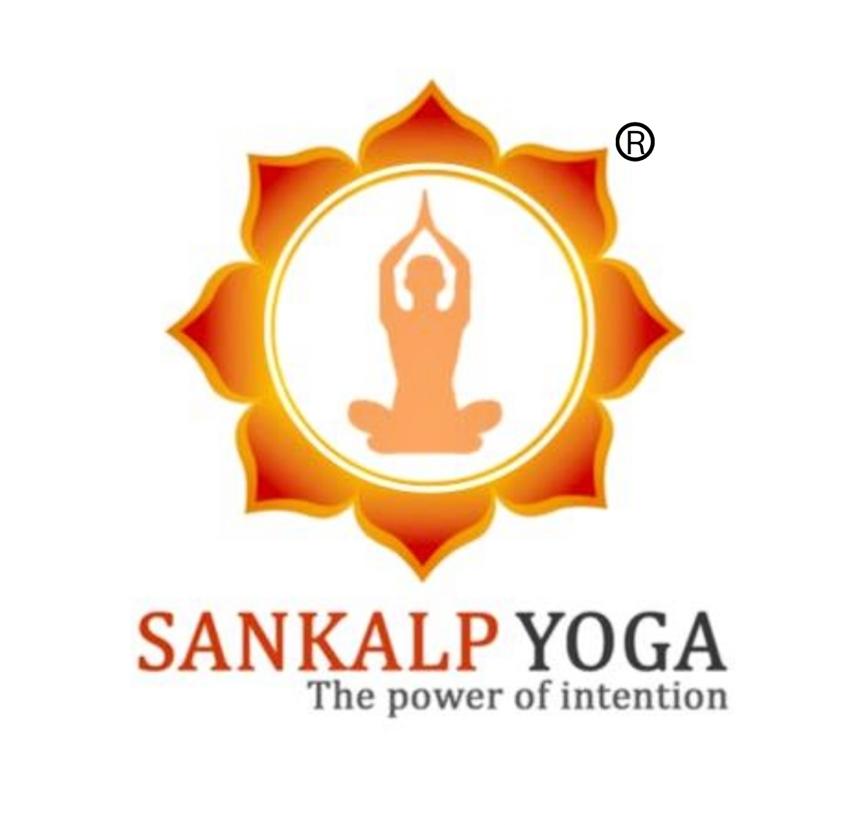PRENATAL AND POSTNATAL YOGA
TEACHER TRAINING CERTIFICATIONS
Learn how to use basic and simple Yoga for all phases of Safe Motherhood
Prenatal and Postnatal Yoga Teacher Training Certifications
Safe motherhood – In these words, Ayurveda, the ancient Indian medical science, describes “safe motherhood” through our Simple Yoga and Basic Yoga Prenatal Yoga Therapist
“Motherhood is the basis of family life which, in turn, is the backbone of all the orders of society. Hence, family life remains protected if the woman is safe and protected.”
This great science compares conception to the germination and sprouting of a seed and its transformation into a sapling. When the male and female seeds unite and the soul enters the union, it becomes an embryo (garbha).
Ayurveda gives importance to the quality of the seed and hence, to the development during adolescence, of both the male and the female. In addition to the female seed, the mother also provides the ‘soil, nutrition and the right season’ for the seed to grow. Hence, Ayurveda advises
special attention to be paid to the nutrition and protection of the woman to keep her (the soil) rich and clean. It further advises that a female under sixteen years of age and a male under twenty should not bear a child. The rules of sexual intercourse are also laid down. So also, those of antenatal care: the husband and other family members are advised to take care of the pregnant woman’s diet and encourage activities that are dear to her and beneficial to the fetus or child growing in her body. Thus, the approach towards motherhood, that is pregnancy and childbirth, is a holistic one.
We will be covering all the aspects right from – before conception to the baby is born and also on up bringing of your child, inculcation proper values in them. Samskara plays an important role in it. Garbhini Paricharya, proper understanding of Garbhaupaghatkar bhavas, sutika paricharya, Bal paricharya, mantras chanting all are important aspect of Garbha Matha Samskar. AaharAahar, Vihaar, Aachaar, Vichaar of the Mother (Matha) would play a key role. Pregnancy is not just pill of calcium, Iron, Exercises but much beyond that where a lady experiences a joy of bringing a life in this world. She is attached to a life with in her. The joy of experiencing two heart beats with one self cannot be put in words.
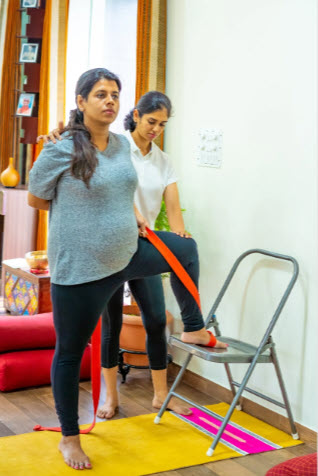
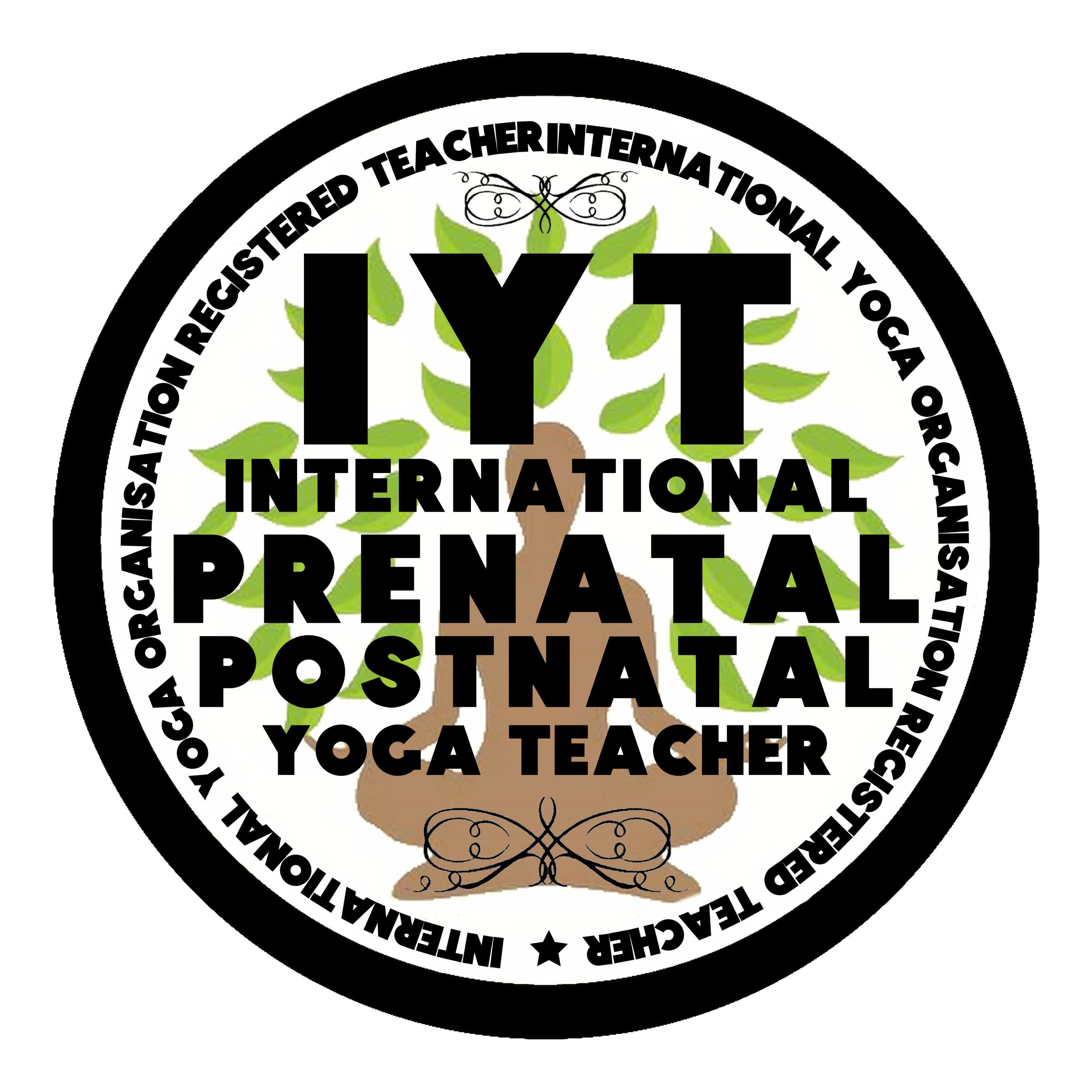
SYLLABUS OF
PRENATAL AND POSTNATAL YOGA TEACHER TRAINING
The course sheds light on physiological and psychological changes and needs of pregnant women. It will enable yoga teacher to modify yoga practices according to needs of pregnant women based on trimester she is in. It will also provide knowledge of pre-conception and post natal practice that will aid in overall development of practitioner. Complications such as pre-mature labour, miscarriage etc will also be covered.
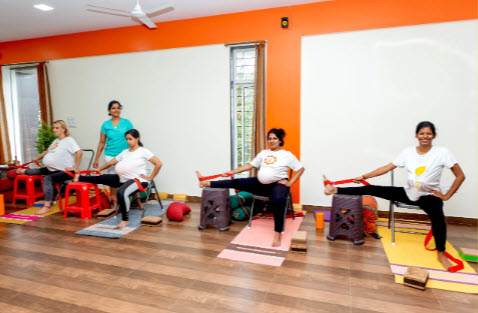
1) ASANA METHODOLOGY
A. Asana Practice, Vinyasa Krama and its Core Principles
B. Learning to Sequence according to a particular disease.
C. Learning How to Draw Postures.
D. The Science of Asanas and their Therapeutic effects
- Standing Postures
- Balancing
- Forward Bending Postures Meditation Postures
- Back Bending Postures
- Twisting Postures
- Inverted Postures
- Relaxation Postures
E. Outline of health assessment for patients/students.
F. Teaching Practicum
2) Mysore style of Yoga
Theme: About Healing
Duration: 8 hours
Topics:
- The philosophy behind Nada yoga and chakras
- Mantra/beeja mantra
- Energy Centers (CE)
- Location and Function (CE)
- Musical spectrum
3) Relaxation Techniques
Modern and fast-paced lifestyle as well as connection to external stimuli (such as digital devices) has created an inability to relax and let go. This in turn may express itself as fear, anxiety, inability to make decisions, depression, loneliness, etc.
Through several relaxation techniques we invite the future yoga therapist to help reconnect his/her students with the “here and now”.
A. Quick Relaxation Technique
A guided 10 to 15 minutes practice which helps release emotional and mental tensions. The student learns how to guide this and is free to apply it on his/her teaching practicum.
B. Yoga Nidra
Origins and applications of yoga nidra. The student is asked to create its own yoga nidra script as well as learning to create a relaxing voice to guide this practice.
C. Chakra Breathing and Chakra Sounds Techniques
D. Tibetan Bowl Healing and Relaxation Techniques
Practice to connect with the deep sound of the Tibetan bowls and learn how to meditate on “nada”, the inner sound. Learning to use singing bowls as part of your teaching skills is an important part of a classroom setting as it helps tap on the ability of self-healing innate on each human being.
E. Using of tunning forks
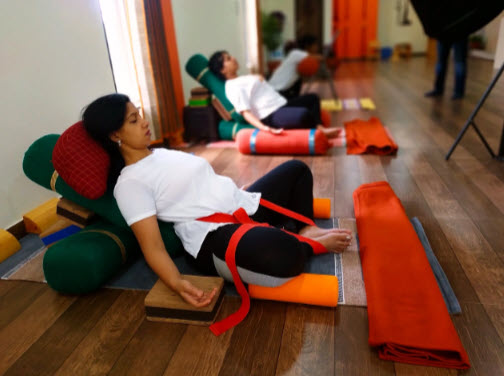
4) Pranayama (breathing exercises) & Bandhas
Understanding the connection of the body/mind system with the pranic or vital body. Introduction to the essence of prana (life energy) and its applications towards helping reduce the impact of a disease.
How do we breath?
- The 4 essential aspects of Pranayama
- How to introduce the practitioner to his/her natural breath
- Abdominal, Thoracic & Clavicular Breathing
- Full Yogic Breath, Ujjayi Breath
- Nadi Shodhana, Brammhari, Bhastrika, Kapalabhati, Sheetali & Sheetkari
- Moola, Uddhyana, Jalandhara & Maha Bandha.
Students will be asked to put these aspects of pranayama into practice by learning how to guide several breathing practices.
5) Mudras (Yoga in your hands)
- What are Mudras
- Preparing the body/mind system for the use of mudras.
- Connection of Mudras and Ayurveda
- Connection of Mudras and the Chakras
- Guiding mudras on an individual or group basis.
- Using mudras to help heal physical problems such as lower back pain, arthritis, digestive disorders, high blood pressure, respiratory disorders, etc.
- Using mudras to help heal emotional problems such as anxiety, depression, sense of self-worth, lack of focus, etc.
- Essential Mudras of Yoga for Meditation Practices (Chin Mudra, Jnana Mudra, Shambavi Mudra, Nasikagra Mudra, Prana Mudra, Shanmukhi Mudra, Kechari & Kaki Mudra)
- Mudras to balance the doshas of the body
6) The Yogic Diet
- Food
- Relationship between food and our emotion
- The Yogic Diet vs. the Ayurvedic Diet
AYURVEDIC APPROACH IN PRENATAL AND POSTNATAL YOGA TEACHER TRAINING
120 HRS CERTIFICATION
APPLY THE ANCIENT KNOWLEDGE OF AYURVEDA DURING MATERNITY
GARBHA MATHA SAMSKARA
Garbha Matha Samskar is all about nurturing your fetus physically, emotionally and spiritually across your womb. Garbh Matha samskara whose effects can pour through generations and can actually make a change in society.
Garbha matha samskara includes particular methods for getting desired pregnancy, maintaining proper health of the mother during pregnancy and finally ends with normal, uncomplicated easy delivery of a healthy baby.
Garbha matha samskara is an important part of Ayurveda and was integral with social practices of our ancestors. Probably, the reason why our ancestors were healthier in the real sense. Though it is being rediscovered today, few of the key aspects are often overlooked.
The title itself underlines the delicacy of the pregnancy so also the NEED of Garbha Matha Samskar. The reason behind highlighting the word – need is for reflecting its importance in healthy pregnancy and future generation rather than seeing at it just as a ‘Trend’. Westernization flushed out many good customary practices along with anti-social and illiberal traditions.
Garbhadhan is counted among 16 sanskaras which are actually life changing events in one’s life and need due attention and cautious efforts.
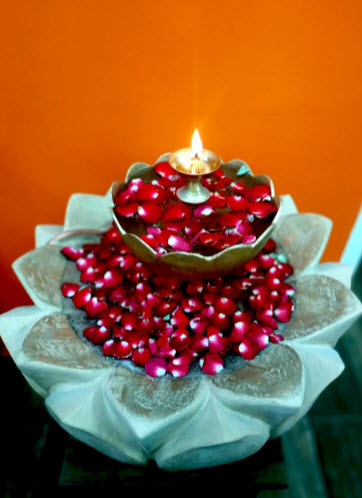
SYLLABUS OF THE AYURVEDIC PRENATAL AND POSTNATAL TEACHER TRAINING CERTIFICATIONS
Ayurveda Topics
- Introduction to Garbha Maths Samskara
- Parenting Art Nites
- Shodashasamskara
- Mantras
- Garbhiniparicharya-1st trimester
- Garbhiniparicharya-2nd trimester
- Soothikaparicharya
- Beauty tips for garbhini and sutika
- Balaparicharya
- Agnihothra
- Heart womb Meditation
- Yoga Nidra
- Case study
1) ASANA METHODOLOGY
A. Asana Practice, Vinyasa Krama and its Core Principles
B. Learning to Sequence according to a particular disease.
C. Learning How to Draw Postures.
D. The Science of Asanas and their Therapeutic effects
- Standing Postures
- Balancing
- Forward Bending Postures Meditation Postures
- Back Bending Postures
- Twisting Postures
- Inverted Postures
- Relaxation Postures
E. Outline of health assessment for patients/students.
F. Teaching Practicum
2) Mysore style of Yoga
Teaching how to use Krishnamacharya Yoga Mandiram techniques to build Mysore Style of Yoga Practice which enables the growth of the teacher as well as the student.
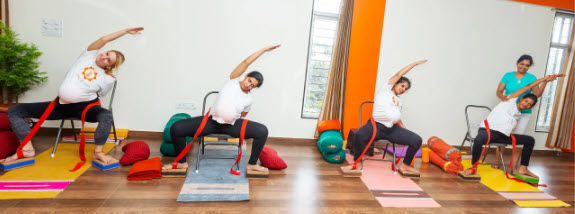
3) Relaxation Techniques
Modern and fast-paced lifestyle as well as connection to external stimuli (such as digital devices) has created an inability to relax and let go. This in turn may express itself as fear, anxiety, inability to make decisions, depression, loneliness, etc.
Through several relaxation techniques we invite the future yoga therapist to help reconnect his/her students with the “here and now”.
A. Quick Relaxation Technique
A guided 10 to 15 minutes practice which helps release emotional and mental tensions. The student learns how to guide this and is free to apply it on his/her teaching practicum.
B. Yoga Nidra
Origins and applications of yoga nidra. The student is asked to create its own yoga nidra script as well as learning to create a relaxing voice to guide this practice.
C. Chakra Breathing and Chakra Sounds Techniques
D. Tibetan Bowl Healing and Relaxation Techniques
Practice to connect with the deep sound of the Tibetan bowls and learn how to meditate on “nada”, the inner sound. Learning to use singing bowls as part of your teaching skills is an important part of a classroom setting as it helps tap on the ability of self-healing innate on each human being.
E. Using of tunning forks
4) Pranayama (breathing exercises) & Bandhas
Understanding the connection of the body/mind system with the pranic or vital body. Introduction to the essence of prana (life energy) and its applications towards helping reduce the impact of a disease.
- How do we breath?
- The 4 essential aspects of Pranayama
- How to introduce the practitioner to his/her natural breath
- Abdominal, Thoracic & Clavicular Breathing
- Full Yogic Breath, Ujjayi Breath
- Nadi Shodhana, Brammhari, Bhastrika, Kapalabhati, Sheetali & Sheetkari
- Moola, Uddhyana, Jalandhara & Maha Bandha
Students will be asked to put these aspects of pranayama into practice by learning how to guide several breathing practices.
5) Mudras (Yoga in your hands)
- What are Mudras
- Preparing the body/mind system for the use of mudras.
- Connection of Mudras and Ayurveda
- Connection of Mudras and the Chakras
- Guiding mudras on an individual or group basis.
- Using mudras to help heal physical problems such as lower back pain, arthritis, digestive disorders, high blood pressure, respiratory disorders, etc.
- Using mudras to help heal emotional problems such as anxiety, depression, sense of self-worth, lack of focus, etc.
- Essential Mudras of Yoga for Meditation Practices (Chin Mudra, Jnana Mudra, Shambavi Mudra, Nasikagra Mudra, Prana Mudra, Shanmukhi Mudra, Kechari & Kaki Mudra)
- Mudras to balance the doshas of the body
6) The Yogic Diet
- Food
- Relationship between food and our emotion
- The Yogic Diet vs. the Ayurvedic Diet
